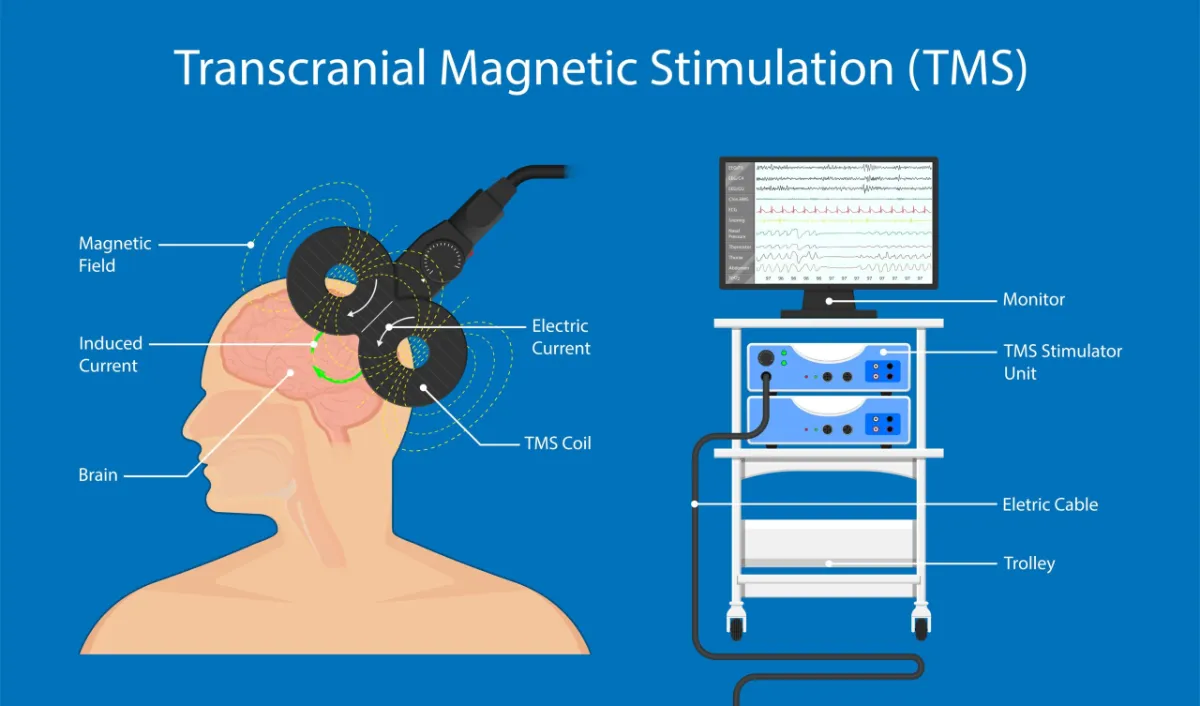Transcranial Magnetic Stimulation (TMS) is a noninvasive treatment that uses magnetic pulses to stimulate specific parts of the brain. While it’s mainly used to treat depression, research suggests it might also help with bipolar disorder.
Here’s what you need to know about TMS for bipolar disorder, including its potential benefits, risks, and how to try it.
What is TMS?
TMS is a treatment that uses magnetic fields to stimulate nerve cells in the brain. It’s FDA-approved for:
- Major depressive disorder (MDD).
- Obsessive-compulsive disorder (OCD).
Because depression is a key symptom of bipolar disorder, researchers are exploring whether TMS could help with bipolar disorder too.
Potential Benefits of TMS for Bipolar Disorder
Bipolar disorder involves episodes of mania (high energy) and depression (low energy). So far, most research on TMS for bipolar disorder focuses on its ability to ease depressive symptoms, such as:
- Lack of energy.
- Feelings of sadness or hopelessness.
- Loss of interest in activities.
- Trouble sleeping or sleeping too much.
- Difficulty concentrating or making decisions.
- Thoughts of suicide.
TMS has few side effects, making it a good option for people who haven’t responded to other treatments.
What Does the Research Say?
Studies show promising results for TMS in treating bipolar depression:
- A 2019 review found that TMS significantly reduced depressive symptoms in people with bipolar disorder. However, its effects on manic symptoms were unclear.
- A 2020 study of 44 people with bipolar depression found that 77% saw their symptoms improve after TMS. About 41% experienced full remission (little to no symptoms).
- A 2021 review highlighted the need for more research to determine the best way to use TMS for bipolar disorder, including the right frequency and brain areas to target.
While the results are encouraging, more research is needed to fully understand how TMS can help with bipolar disorder.
FDA’s Stance on TMS for Bipolar Disorder
In 2020, the FDA gave TMS a “breakthrough device designation” for treating bipolar disorder. This doesn’t mean it’s officially approved, but it shows the FDA sees potential in the treatment and is speeding up its review process.
Risks and Side Effects
TMS is generally safe, with mild side effects, such as:
- Mild pain or discomfort during the procedure.
- Lightheadedness or headaches.
- Tingling in the face, scalp, or jaw.
- Temporary hearing difficulties.
In rare cases, TMS may trigger a manic episode in people with bipolar disorder. More research is needed to understand this risk.
Who Should Avoid TMS?
TMS isn’t safe for everyone. Avoid it if you:
- Have a history of seizures or brain injuries.
- Have metal, magnetic, or implanted devices in your body (e.g., pacemakers, cochlear implants).
How to Try TMS
If you’re interested in TMS, talk to your doctor or therapist. They can refer you to a specialist who offers TMS.
Cost of TMS
- In the U.S., TMS costs 230to334 per session.
- Most people need 20 to 30 sessions, so the total cost can add up.
- Medicare and some insurance plans may cover part of the cost.
Clinical Trials
You can also participate in a clinical trial to try TMS. Search for studies near you on ClinicalTrials.gov or ask your doctor for recommendations.
Key Takeaways
- TMS is a noninvasive treatment that uses magnetic pulses to stimulate the brain.
- It’s FDA-approved for depression and OCD, and research suggests it may help with bipolar depression.
- Side effects are usually mild, but TMS isn’t safe for everyone.
- If you’re interested in TMS, talk to your doctor or look into clinical trials.
While TMS shows promise for bipolar disorder, more research is needed to understand its full potential. If you’re struggling with bipolar depression, TMS could be a helpful option to explore.

